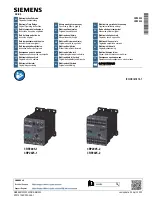
7
Operation
indicators
Each stage has its own operation indicator
shown as a red figure to the left in the digital
display. Further, all stages have a common indi-
cator named "TRIP"; a red led indicates that
the module has delivered a tripping signal.
The operation indicator on the display remains
illuminated when the stage resets, thus indicat-
ing which protection stage was operating.
If start of a stage does not last long enough to
cause a trip, the start indication on the display
is normally self-reset when the stage is reset. If
needed, the start indicators can be given a latch-
ing function by means of switches SGF/3...4.
The following table shows the start and trip in-
dicators on the display and their meanings.
Indication
Explanation
1
I
a
> alarm
= The overload stage I
a
> has given an alarm
2
I
b
> start
= The overload stage I
b
> has started
3
I
b
> trip
= The overload stage I
b
> has tripped
4
∆
I
1
> alarm
= Stage
∆
I
1
> has given an alarm
5
∆
I
2
> start
= Stage
∆
I
2
> has started
6
∆
I
2
> trip
= Stage
∆
I
2
> has tripped
7
I< operation
= Stage I< has operated
8
t
rec
= Reconnection inhibit is active, indication is self-reset
9
EXT.TRIP
= A trip from an external relay has been carried out via the relay
The self-supervision alarm indicator IRF indi-
cates that the self-supervision system has de-
tected a permanent fault. The indicator is lit
with red light about 1 minute after the fault has
been detected. At the same time the plug-in
module delivers a signal to the self-supervision
system output relay of the protection assembly.
Additionally, in most cases, a fault code show-
ing the nature of the fault appears on the dis-
play of the module. The fault code, consists of
a red figure one and a green code number, can-
not be erased from the display of the module
by resetting. When a fault occurs, the fault code
should be recorded and stated when service, is
ordered.
















































